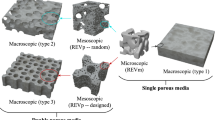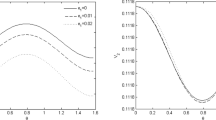Abstract
Transient oblique reflection of resolved compaction shocks in porous material from a rigid planar boundary is computationally examined to characterize how spatial reflection structures vary with reflection angle. The material response is described by a hydrodynamic theory that accounts for both elastic and inelastic volumetric deformation. The mathematical model, expressed in terms of curvilinear coordinates, is numerically integrated using a high-resolution technique. Emphasis is placed on characterizing the relative importance of compression and compaction work as heating mechanisms. Spatially continuous structures are predicted that propagate at speeds below the ambient sound speed of the solid component which are analogous to discontinuous structures for oblique reflection of gas shocks. An analogous transition from a von Neumann reflection to a Mach reflection to a regular reflection is predicted with increasing reflection angle, with high dissipative heating induced by configurations possessing a stem-like structure. Compression and dissipation by rate-dependent compaction are shown to be primary heating mechanisms, whereas dissipation by inelastic compaction is of secondary importance.



















Similar content being viewed by others
References
Baer, M.R., Nunziato, J.W.: A two-phase mixture theory for the deflagration-to-detonation transition (DDT) in reactive granular materials. Int. J. Multiph. Flow 12(6), 861–889 (1986)
Bdzil, J.B., Menikoff, R., Son, S.F., Kapila, A.K., Stewart, D.S.: Two-phase modeling of deflagration-to-detonation transition in granular materials: a critical examination of modeling issues. Phys. Fluids 11(2), 378–402 (1999)
Ben-Dor, G.: Shock Wave Reflection Phenomena. Springer, Berlin (2007)
Brown, B.P., Argrow, B.M.: Two-dimensional shock tube flow for dense gases. J. Fluid Mech. 349, 95–115 (1997)
Coyne, P.J. Jr., Elban, W.L., Chiarito, M.A.: The strain rate behavior of coarse HMX porous bed compaction. In: Eighth International Detonation Symposium, pp. 645–657 (1989)
Elban, W.L., Chiarito, M.A.: Quasi-Static compaction study of coarse HMX explosive. Powder Technol. 46, 181–193 (1986)
Field, J.E., Palmer, S.J.P., Pope, P.H., Sundararajan, R., Swallowe, G.M.: Mechanical properties of PBX’s and their behavior during drop-weight impact. In: Proceedings of Eighth International Symposium on Detonation, pp. 635–644 (1985)
Glaz, H.M., Colella, P., Glass, I.I., Deschambault, R.L.: A numerical study of oblique shock-wave reflections with experimental comparisons. Proc. R. Soc. Lond. Ser. A 398(1814), 117–140 (1985)
Gibbs, T.R., Popolato, A.: LASL Explosive Property Data. University of California Press, Berkeley (1980)
Gonthier, K.A., Menikoff, R., Son, S.F., Asay, B.W.: Modeling compaction induced energy dissipation of granular HMX. In: Proceedings of the \(11^{th}\) Detonation Symposium, pp. 153–161 (1998)
Gonthier, K.A.: Modeling and analysis of reactive compaction for granular energetic solids. Combust. Sci. Technol. 175, 1679–1709 (2003)
Gonthier, K.A.: Predictions for weak mechanical ignition of strain hardened granular explosive. J. Appl. Phys. 95(7), 3482–3494 (2004)
Gonthier, K.A., Jogi, V.: Multiscale shock heating analysis of a granular explosive. J. Appl. Mech. 76(4), 538–552 (2005)
Gonthier, K.A., Cox, C.F.: Predictions for the impact of a granular solid having spatially non-uniform bulk porosity. Comput. Mech. 39, 419–437 (2007)
Gonthier, K.A., Chakravarthy, S.: Shock induced ignition of porous HMX—a computational examination of hot-spot formation rates. In: Proceedings of the 15th International Detonation Symposium, 13–18 July, San Francisco, to appear (2014)
Heavens, S.N., Fields, J.E.: The ignition of a thin layer of explosive by impact. Proc. R. Soc. Lond. Ser. A 338, 77–93 (1974)
Hornung, H.G., Oertel Jr, H., Sandeman, R.J.: Transition to mach reflection of shock waves in steady and pseudo-steady flows with and without relaxation. J. Fluid Mech. 90, 541–560 (1979)
Keshavarz, M.H., Pouretedal, H.R.: Simple empirical method for prediction of impact sensitivity of selected class of explosives. J. Hazard. Mater. 124, 27–33 (2005)
Kimura, E., Oyumi, Y.: Sensitivity of solid rocket propellants for card gap test. Propellants Explos. Pyrotech. 24, 90–94 (1999)
Krishna Mohan, V., Jyothi Bhasu, V.C., Field, J.E.: Role of adiabatic shear bands in initiation of explosives by drop-weight impact. In: Proceedings of Ninth International Symposium on Detonation, pp. 1276–1283 (1989)
Kurganov, A., Tadmor, E.: New high-resolution central schemes for nonlinear conservation laws and convection-diffusion equations. J. Comput. Phys. 160, 241–282 (2000)
Licht, H.H.: Performance and sensitivity of explosives. Propellants Explos. Pyrotech. 25, 126–132 (2000)
Macek, A.: Sensitivity of explosives. Chem. Rev. 62, 41–63 (1962)
Mandal, A.: Computational examination of compaction wave-boundary interaction in granular explosive. Thesis, Louisiana State University, Baton Rouge, Louisiana (2010) (http://etd.lsu.edu/docs/available/etd-08112010-163505)
McAfee, J.M., Asay, B.W., Campbell, W., Ramsay, J.B.: Deflagration to detonation transition in granular HMX. In: Proceedings of the Ninth International Symposium on Detonation, pp. 265–278 (1989)
McAfee, J.M.: Characterization of high-explosive initiation and safety at Los Alamos. Los Alamos National Laboratory Technical Report, LA-UR-94-3316 (1994)
Panchadhar, R., Gonthier, K.A.: Mesoscale analysis of volumetric and surface dissipation in granular explosive induced by uniaxial deformation waves. Shock Waves 21(1), 43–61 (2010)
Powers, J.M., Stewart, D.S., Krier, H.: Analysis of steady compaction waves in porous materials. J. Appl. Mech. 56, 15–24 (1989)
Rao, P., Gonthier, K.A.: Reactive burn modeling of porous solid explosives. American Institute of Aeronautics and Astronautics Paper AIAA 2014-2810. Presented at the AIAA Propulsion and Energy Forum and Exposition, Cleveland, Ohio, 28–30 July (2014)
Sandusky, H.W., Liddiard, T.P.: Dynamic compaction of porous beds. NSWC TR 83-246, Naval Surface Weapons Center (1985)
Sheffield, S.A., Gustavsen, R.L., Anderson, M.U.: Shock Loading of Porous High Explosives. High-Pressure Shock Compression of Solids, vol. IV, pp. 24–61. Springer-Verlag, New York (1997)
Shu, C.W., Osher, S.: Efficient implementation of essentially non-oscillatory shock-capturing schemes. J. Comput. Phys. 77, 439–471 (1988)
Strang, G.: On the construction and comparison of difference schemes. SIAM J. Numer. Anal. 5(3), 506–517 (1968)
Walley, S.M., Field, J.E., Palmer, S.J.P.: Impact sensitivity of propellants. Proc. Math. Phys. Sci. 438(1904), 571–583 (1992)
Wilson, W.H., Tasker, D.G., Dick, R.D., Lee, R.J.: Initiation of explosives under high deformation loading conditions. In: Proceedings of the Eleventh Detonation (International) Symposium, pp. 565–572. Snowmass (1998)
Woodward, P., Colella, P.: The numerical simulation of two-dimensional fluid flow with strong shocks. J. Comput. Phys. 54, 115–173 (1984)
Acknowledgments
The authors gratefully acknowledge funding for this work provided by the U.S. Air Force Office of Scientific Research (AFOSR) under Contract Number FA9550-06-1-0121 and the U.S. Air Force Research Laboratory (AFRL-MNME), Eglin AFB, Florida, under Contract Number FA8651-06-1-0005. Portions of this research were conducted with high-performance computational resources provided by Louisiana State University (http://www.hpc.lsu.edu).
Author information
Authors and Affiliations
Corresponding author
Additional information
Communicated by F. Zhang and A. Higgins.
Appendix: Constitutive relations for granular HMX
Appendix: Constitutive relations for granular HMX
Constitutive relations used in this study describe the state behavior of the solid component HMX and the compaction behavior of granular HMX.
A Mie-Grüneisen equation of state is used to describe the thermodynamics:
where \(\nu _{s0} = 1/\rho _{s0}\) is the initial mass-specific volume and \(\varGamma \) is a constant Grüneisen coefficient. The functions \(P_H(\nu _\mathrm{s})\) and \(e_H(\nu _\mathrm{s})\) are defined by
where \(\nu _\mathrm{s} = 1/\rho _\mathrm{s}\) is the local mass-specific volume. This incomplete equation of state is compatible with the shock Hugoniot \(D = \omega + s U_p\), where D is the shock speed, \(U_p\) is the particle velocity behind the shock, and \(\omega \) and s are empirically determined constants [9]. The equation of state is completed by the caloric equation \(e_\mathrm{s} = c_v \left( T_\mathrm{s} - T_{0}\right) \), where \(c_v\) is the constant volume specific heat and \(T_{0}\) is the initial temperature. Values of the constant parameters used for the equation of state are listed in Table 2.
The sound speed of HMX is needed for use with the shock-capturing numerical technique. It is defined by
where \(\eta \) is the solid entropy. Based on the Mie-Grüneisen equation of state
where
Expressions for the compaction of granular HMX are based on quasi-static data [5, 6]. The intergranular stress \(\beta \) and the yield surface for onset of inelastic volumetric deformation f are given by
where \(\beta _c = 6.0\) MPa, \(c = 0.913\), \(\kappa = 0.03\), and \(\phi _{fp} = 0.655\) [10]. This expression for \(\beta \) is a monotonically increasing function of the elastic component of volume fraction \(\phi -\tilde{\phi }\) and contains a linear dependence on solid density as required by thermodynamic constraints [14]. The expression for f is a monotonically increasing function of \(\phi \) which is indicative of work hardening. Using (63), the following expression for the compaction potential energy \( B = \int _0^{(\phi -\tilde{\phi })} \frac{\beta }{\rho _\mathrm{s} \phi }\, d(\phi - \tilde{\phi })\) is obtained:
Rights and permissions
About this article
Cite this article
Mandal, A., Gonthier, K.A. Thermomechanics of transient oblique compaction shock reflection from a rigid boundary. Shock Waves 25, 589–610 (2015). https://doi.org/10.1007/s00193-015-0583-2
Received:
Revised:
Accepted:
Published:
Issue Date:
DOI: https://doi.org/10.1007/s00193-015-0583-2




